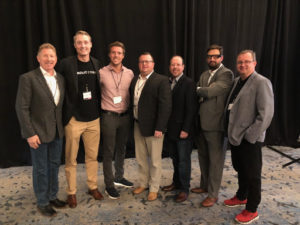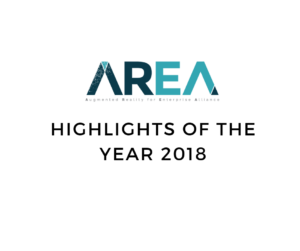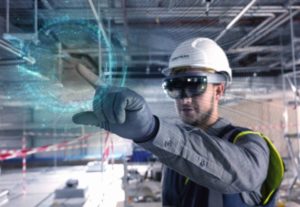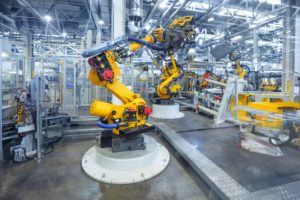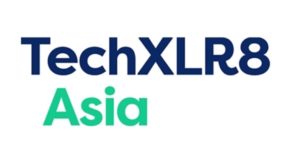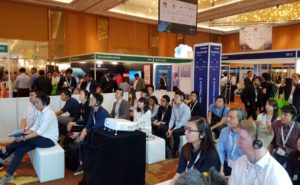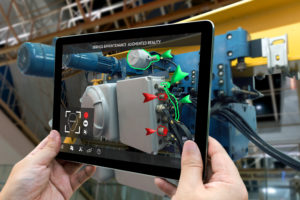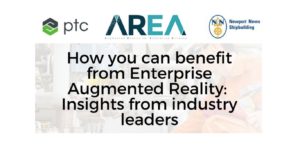The first half of 2018 was full of AR conferences – and the AREA was a big part of it all. It all kicked off in March with the workshop the AREA co-hosted with DMDII in Chicago. From there, the AR event season was off and running – and with many shows offering discounts for AREA members, it was no surprise to see many AREA members at the AR events held around the world.
As Executive Director of the AREA I’m honored to present at these events, showing the progress made by the industry and the importance of the AREA and its members. Here are my reflections on the events I’ve attended in recent months, including the initiatives the AREA trialed in early 2018.
First, my overall impression. There is a strong and growing interest in enterprise AR. Attendance and enthusiasm are on the rise and enterprises are now discussing real implementations and real benefits. That momentum was reflected at all of the following conferences I attended:
Wearable Technology Show (March, London)
This conference focused on the AR wearable space marked a first for the AREA: our first dedicated workshop focused on enterprise AR. AREA members XMReality, RealWear, and MTC, supported by AREA Researcher Michael Rygol and Welsh Water created an excellent set of experts! The workshop targeted enterprises interested in finding out more about the benefits of AR and seeking to engage with experts to get answers to their questions. The session was well received by all and served as an effective model for our participation at future events.
AR VR Innovate (May, Dublin)
The AREA has supported this event for the past three years. It brings together Ireland’s leading companies, as well as a number of innovative AR and VR companies, government agencies and investors. This year, the AREA sponsored a panel session where Amina Naqvi of AREA member MTC and Gary Smith of Welsh Water provided expert insight into the benefits of AR and how to overcome the challenges of AR implementation.
VRX Europe (May, Amsterdam)
Again the AREA sponsored a panel session delivered with AREA members. This was the first time the AREA had supported this event and it proved to be a good format with plenty of opportunities for discussion. The audience appreciated the panel session and we generated lots of interest in the AREA’s work.
AWE US 2018 (May, Santa Clara)
It’s the biggest AR event of the year and the AREA continues to support it in numerous ways. We helped to develop the work (enterprise) speaker track and provided chairs for the three days (thank you, Christine Perey and Carl Byers, for joining me).
Many AREA members spoke at the event and provided considerable insight to the attendees. It was great to hear Boeing and Lockheed Martin talk about real savings realized from their AR projects. Another common theme was that more and more AR projects are becoming “industrialized” (i.e., moving from trials and pilots to becoming part of an organization’s day-to-day tools).
As per our tradition, the AREA had the honor of kicking off the three days of enterprise speaker tracks with my presentation, “Fulfilling the Potential of AR for Enterprise.”
The AREA also hosted a breakfast briefing for members, interested enterprises and partners. It was great to hear from various board members (Beth Scicchitano, (Newport News Shipbuilding), Christine Perey, (PEREY Research & Consulting) and Marc Schuetz (PTC) about how they are benefiting from the work of the AREA.
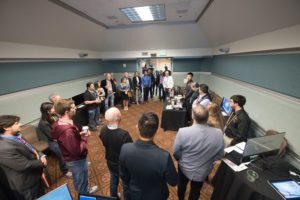
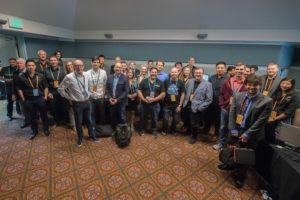
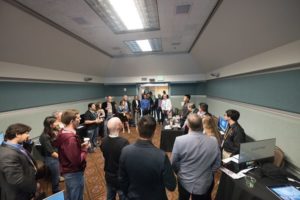
IATA Aviation Virtual and Augmented Reality Summit (June, Geneva)
A quick turnaround (less than one day at home) saw me back on a plane to Geneva for the inaugural International Air Transport Association (IATA) VR and AR Summit. Focused on the aviation industry, this event’s attendees included many of the world’s leading airlines. I was pleased to present the work of the AREA to an engaged and enthusiastic audience.
AR & VR World (June, London)
AR & VR World is part of an event called TechXLR8, which includes other technologies (this year they included IoT, 5G, and AI). The AREA also tested a new concept called the AREA Pavilion. Six AREA members – 3D Studio Blomberg, AMRC, Crunchfish, Mira Labs, Theorem Solutions, and XMReality – shared a dedicated AREA space. This helped to reduce costs but also enabled me and other attendees to speak to multiple members and attendees. Angela Lang, who drives AREA Events and Media Partnerships, and I, will continue to develop the Pavilion concept, both for AR events and industry events.
All in all, it was a busy and vibrant AR event season that clearly demonstrated growing enterprise interest in AR. Thanks to all our members who participated and helped to bring the work of the AREA to an eager world!
